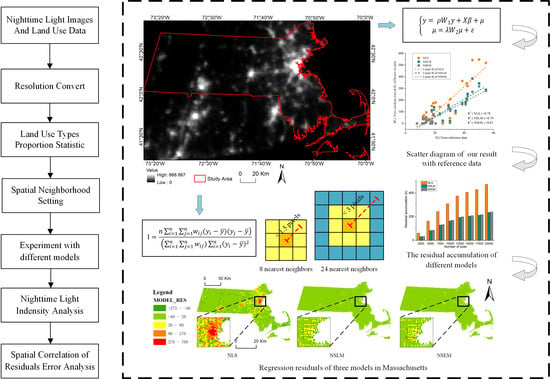Developing Non-Negative Spatial Autoregressive Models for Better Exploring Relation Between Nighttime Light Images and Land Use Types
Abstract
1. Introduction
2. Methods
2.1. Study Area and Data Sources
2.2. Data Preprocessing
2.2.1. Resolution Conversion
2.2.2. Spatial Neighborhood Setting
2.2.3. Land Use Types Proportion Statistic
2.3. Spatial Autoregressive Model Construction
2.3.1. Traditional Spatial Autoregressive Model
2.3.2. Improved Non-Negative Spatial Lag Model (NSLM)
2.3.3. Improved Non-Negative Spatial Error Model (NSEM)
3. Results
3.1. Comparative Analysis of Nighttime Light Intensity
3.2. Spatial Correlation of Residual Error Analysis
4. Discussion
4.1. Nighttime Light Contribution of Urban Land Use Classes
4.2. Main Cause and Distance Threshold of Spatial Autocorrelation
4.3. Potential Use Case
5. Conclusions
Author Contributions
Funding
Conflicts of Interest
Appendix A
| City | Berlin | Massachusetts | Shenzhen |
|---|---|---|---|
| Moran’s I | 0.766 | 0.971 | 0.833 |
| Land Use Type | NLI | |||
|---|---|---|---|---|
| RD | NLS | NSLM | NSEM | |
| cropland | 11.36 | 0.00 | 0.00 | 0.00 |
| pasture | 11.99 | 0.00 | 0.00 | 0.00 |
| forest | 12.85 | 0.89 | 2.13 | 1.70 |
| Non-forested wetland | 14.07 | 9.37 | 11.48 | 7.82 |
| mining | 15.94 | 33.52 | 34.48 | 29.13 |
| open land | 17.75 | 0.00 | 0.00 | 0.00 |
| participation recreation | 34.13 | 86.80 | 108.24 | 100.59 |
| spectator recreation | 38.74 | 364.30 | 175.72 | 164.25 |
| water-based recreation | 20.58 | 180.08 | 0.00 | 0.00 |
| multifamily residential | 50.16 | 548.43 | 343.14 | 317.27 |
| high-density residential | 30.53 | 208.97 | 121.39 | 108.70 |
| medium-density residential | 23.44 | 142.87 | 84.93 | 76.24 |
| low-density residential | 14.14 | 95.47 | 53.28 | 48.34 |
| saltwater wetland | 17.54 | 18.02 | 8.75 | 6.99 |
| commercial | 54.78 | 518.58 | 288.65 | 278.79 |
| industrial | 41.73 | 344.00 | 212.82 | 198.07 |
| transitional | 25.43 | 0.00 | 23.87 | 14.60 |
| transportation | 40.99 | 186.06 | 177.23 | 162.82 |
| waste disposal | 30.32 | 45.11 | 21.42 | 6.23 |
| water | 18.3 | 8.44 | 16.13 | 13.37 |
| cranberry bog | 7.86 | 0.00 | 0.00 | 0.00 |
| powerline/utility | 17.91 | 150.29 | 113.26 | 102.56 |
| saltwater sandy beach | 18.11 | 41.15 | 0.00 | 0.00 |
| golf course | 18.97 | 173.68 | 79.84 | 71.98 |
| marina | 45.61 | 543.06 | 384.66 | 270.96 |
| urban public/institutional | 42.36 | 320.99 | 253.91 | 237.75 |
| cemetery | 29.34 | 160.30 | 150.27 | 129.58 |
| orchard | 12.58 | 70.35 | 42.39 | 39.27 |
| nursery | 14.06 | 33.15 | 30.33 | 27.00 |
| forested wetland | 11.91 | 59.17 | 40.67 | 36.56 |
| very low density residential | 12.43 | 0.00 | 0.00 | 0.00 |
| junkyard | 19.51 | 65.68 | 139.70 | 116.83 |
| brushland/successional | 16.92 | 0.00 | 0.00 | 0.00 |
| regression R2 | 1 | 0.78 | 0.79 | 0.81 |
| Land Use Type | NLI | |||
|---|---|---|---|---|
| RD | NLS | NSLM | NSEM | |
| Dense block-edge development | 126.6 | 0 | 0.00 | 0.00 |
| Closed block-edge development | 134.4 | 25.2 | 9.08 | 19.25 |
| Closed and half-open block-edge | 121.6 | 0 | 0.00 | 0.00 |
| Mixed development | 124.9 | 23.5 | 8.67 | 15.46 |
| Block-edge development with large courts | 115.2 | 3 | 0.00 | 0.00 |
| Row building with architecture row green space | 116.2 | 9.8 | 0.00 | 0.00 |
| Heterogeneous, inner-city mixed development | 145.1 | 5.5 | 53.28 | 77.22 |
| Vacated block-edge development | 131.8 | 26.4 | 8.47 | 29.31 |
| Storey residential building | 131.8 | 25.5 | 26.53 | 45.33 |
| Large residential areas and free-standing high-rise buildings | 126.5 | 10.8 | 0.00 | 0.00 |
| Row building with landscaped green settlement | 116.1 | 10.3 | 0.00 | 2.35 |
| Concentration in detached house areas | 116.7 | 3.6 | 0.00 | 0.00 |
| Rural mixed development | 107 | 0 | 0.00 | 0.00 |
| Vilas and urban villas with park-like garden | 118.7 | 3 | 0.00 | 0.00 |
| Row and duplex houses with yard | 113.6 | 0.8 | 0.00 | 0.00 |
| Freestanding single-family house with yard | 115.2 | 1.7 | 0.00 | 0.00 |
| Weekend houses and allotment garden-like areas | 108.2 | 5.1 | 4.96 | 10.58 |
| Core area | 337.4 | 92.5 | 122.69 | 202.97 |
| Small business and industry, large-scale retail area, high building density | 194.5 | 19.1 | 18.24 | 26.76 |
| Mixed area without character of residential area, high building density | 173.7 | 79.3 | 46.45 | 81.89 |
| Small business and industry, large-scale retail area, low building density | 148.9 | 22.8 | 15.89 | 25.85 |
| Mixed area without character of residential area, low building density | 135.6 | 5 | 1.06 | 0.80 |
| Utilities area | 168 | 26.2 | 23.87 | 39.63 |
| Railway station and railway system without railroad embankment | 155.7 | 13.8 | 9.62 | 20.35 |
| Railroad embankment | 132.1 | 22 | 5.48 | 7.59 |
| Parking lot | 194.9 | 48.3 | 70.34 | 115.71 |
| Other traffic area | 178.6 | 17.1 | 17.24 | 27.92 |
| Airport | 257.4 | 39.4 | 17.97 | 30.72 |
| Administration | 184.9 | 57.9 | 40.42 | 81.35 |
| Culture | 219.4 | 57 | 74.57 | 132.27 |
| Law enforcement | 140.1 | 13.6 | 12.59 | 21.66 |
| School, old buildings | 119.2 | 0 | 0.00 | 0.00 |
| School, new buildings | 117.4 | 19.6 | 3.83 | 12.20 |
| University and research | 139.9 | 20.8 | 1.71 | 4.90 |
| Child day care center | 115.9 | 25 | 18.17 | 37.81 |
| Other youth facilities | 111.1 | 1.2 | 0.00 | 0.00 |
| Campground | 100.7 | 0 | 0.00 | 0.00 |
| Other and heterogeneous public facilities and special areas | 152.7 | 17.2 | 10.40 | 19.33 |
| Church | 253.2 | 75.7 | 80.32 | 118.69 |
| Hospital | 129 | 25.2 | 4.60 | 14.70 |
| City square/promenade | 284.1 | 128.9 | 142.24 | 208.46 |
| Covered sports facilities | 146.8 | 21 | 21.79 | 28.24 |
| Uncovered sports facilities | 124.1 | 15.8 | 3.06 | 8.09 |
| Tree nursery/horticulture | 106.2 | 5.9 | 0.00 | 2.78 |
| Allotment garden area | 108 | 11.5 | 2.71 | 7.76 |
| Park, green area | 111.2 | 17.1 | 1.69 | 7.50 |
| Cemetery | 105.6 | 15.2 | 4.33 | 10.56 |
| Vacant area | 105.6 | 7.2 | 0.00 | 0.00 |
| Agriculture | 178.6 | 17.1 | 17.24 | 27.92 |
| Forest | 101.9 | 3.5 | 0.73 | 2.04 |
| Water | 104.7 | 5.2 | 0.94 | 1.92 |
| Street | 164.9 | 31.9 | 20.71 | 35.45 |
| regression R2 | 1 | 0.71 | 0.75 | 0.75 |
| Land Use Type | NLI | |||
|---|---|---|---|---|
| RD | NLS | NSLM | NSEM | |
| Forest | 4.16 | 0.79 | 2.24 | 0.00 |
| Street | 37.39 | 47.80 | 79.71 | 93.62 |
| Orchard | 8.47 | 1.44 | 4.30 | 0.36 |
| High-density multistory building | 56.34 | 16.12 | 32.15 | 42.24 |
| High-density single-story building | 33.73 | 2.29 | 7.11 | 8.67 |
| Impervious surface | 24.65 | 15.68 | 29.19 | 32.47 |
| Grassland | 22.18 | 1.33 | 7.06 | 6.30 |
| Water | 4.41 | 2.82 | 7.23 | 2.95 |
| Cropland | 6.08 | 0.00 | 0.00 | 0.00 |
| Park, green area | 19.09 | 6.23 | 19.68 | 20.33 |
| Open storage yard | 86.35 | 64.10 | 121.01 | 151.33 |
| Construction site | 26.52 | 12.84 | 26.98 | 30.27 |
| Multistory independent building | 37.09 | 30.38 | 56.60 | 66.75 |
| Single-story building | 73.50 | 0.25 | 5.55 | 14.81 |
| Parking lot | 30.88 | 44.84 | 81.77 | 94.71 |
| Nursery | 2.83 | 0.00 | 2.01 | 0.00 |
| Airport | 88.77 | 118.38 | 208.93 | 253.79 |
| Railway | 37.36 | 37.10 | 73.32 | 86.20 |
| Nature surface | 12.13 | 12.67 | 17.98 | 16.97 |
| Industrial | 40.29 | 58.80 | 93.88 | 110.63 |
| Waste disposal | 8.19 | 4.98 | 10.88 | 7.94 |
| Levee | 2.71 | 0.00 | 0.00 | 0.00 |
| Junkyard | 8.30 | 1.69 | 4.24 | 0.26 |
| Mining | 11.85 | 2.58 | 5.80 | 2.78 |
| Spectator recreation | 41.94 | 23.22 | 45.97 | 55.39 |
| Pool | 37.71 | 0.00 | 0.00 | 1.22 |
| regression R2 | 1.00 | 0.50 | 0.53 | 0.58 |
| Top Ten Lightest Land Use Types at Night | Top Ten Darkest Land Use Types at Night | ||||||
|---|---|---|---|---|---|---|---|
| ID | Berlin | Massachusetts | Shenzhen | ID | Berlin | Massachusetts | Shenzhen |
| 1 | City square/promenade | Multifamily residential | Airport | 11 | Large residential areas and free-standing high-rise buildings | Waste disposal | Grassland |
| 2 | Core area | Commercial | Open storage yard | 12 | Concentration in detached house areas | Forest | Water |
| 3 | Culture | Marina | Industrial | 13 | Rural mixed development | Cropland | Mining |
| 4 | Church | Urban public/institutional | Parking lot | 14 | Vilas and urban villas with park-like garden | Pasture | Pool |
| 5 | Parking lot | Industrial | Street | 15 | Row and duplex houses with yard | Open land | Orchard |
| 6 | Mixed area without character of residential area, high building density | Spectator recreation | Railway | 16 | Freestanding single-family house with yard | Water-based recreation | Junkyard |
| 7 | Administration | Transportation | Multistory independent building | 17 | School, old buildings | Cranberry bog | Forest |
| 8 | Heterogeneous, inner-city mixed development | Cemetery | Spectator recreation | 18 | Other youth facilities | Saltwater sandy beach | Cropland |
| 9 | Storey residential building | Junkyard | High-density multistory building | 19 | Campground | Very low density residential | Nursery |
| 10 | Utilities area | High-density residential | Impervious surface | 20 | Vacant area | Brushland/successional | Levee |

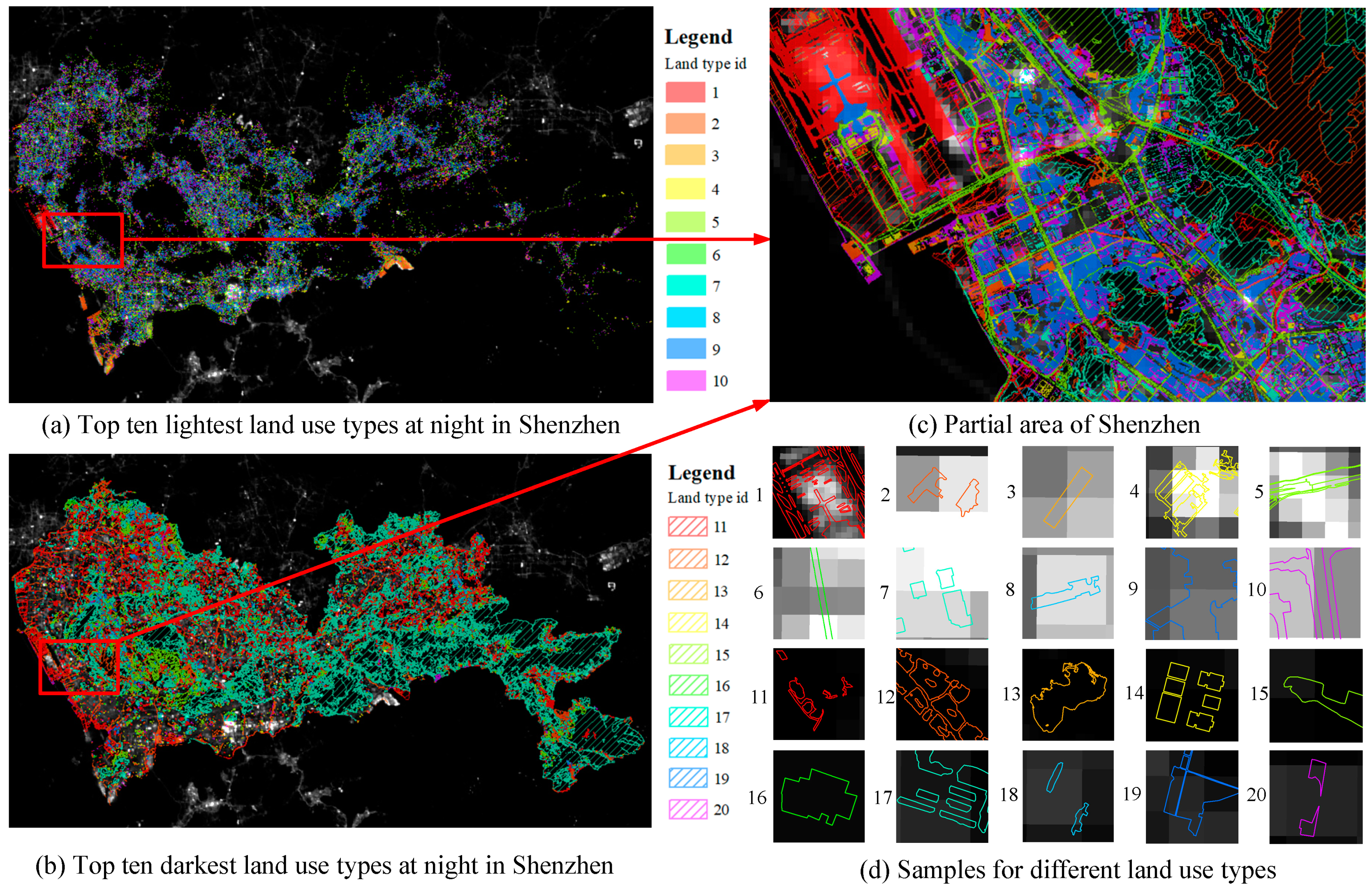
References
- Welch, R. Monitoring urban population and energy utilization patterns from satellite data. Remote Sens. Environ. 1980, 9, 1–9. [Google Scholar] [CrossRef]
- Elvidge, C.D.; Baugh, K.E.; Kihn, E.A.; Kroehl, H.W.; Davis, E.R.; Davis, C.W. Relation between satellites observed visible-near infrared emissions, population, economic activity and electric power consumption. Int. J. Remote Sens. 1997, 6, 1373–1379. [Google Scholar] [CrossRef]
- Shi, K.; Yu, B.; Huang, Y.; Hu, Y.; Yin, B.; Chen, Z.; Chen, L.; Wu, J. Evaluating the Ability of NPP-VIIRS Nighttime Light Data to Estimate the Gross Domestic Product and the Electric Power Consumption of China at Multiple Scales: A Comparison with DMSP-OLS Data. Remote Sens. 2014, 6, 1705–1724. [Google Scholar] [CrossRef]
- Zhuo, L.; Ichinose, T.; Zheng, J.; Chen, J.; Shi, P.J.; Li, X. Modelling the population density of China at the pixel level based on DMSP/OLS non-radiance-calibrated night-time light images. Int. J. Remote Sens. 2009, 30, 1003–1018. [Google Scholar] [CrossRef]
- Bagan, H.; Yamagata, Y. Analysis of urban growth and estimating population density using satellite images of nighttime lights and land-use and population data. Gisci. Remote Sens. 2015, 52, 765–780. [Google Scholar] [CrossRef]
- Liu, Z.; He, C.; Zhang, Q.; Huang, Q.; Yang, Y. Extracting the dynamics of urban expansion in China using DMSP-OLS nighttime light data from 1992 to 2008. Landsc. Urban Plan. 2012, 106, 62–72. [Google Scholar] [CrossRef]
- Keola, S.; Andersson, M.; Hall, O. Monitoring Economic Development from Space: Using Nighttime Light and Land Cover Data to Measure Economic Growth. World Dev. 2015, 66, 322–334. [Google Scholar] [CrossRef]
- Liu, J.; Li, W. A nighttime light imagery estimation of ethnic disparity in economic well-being in mainland China and Taiwan (2001–2013). Eurasian Geogr. Econ. 2014, 55, 691–714. [Google Scholar] [CrossRef]
- Feng, J.; Bai, L.; Wang, K.; Zhang, X.; Xie, N.; Ran, Q.; Guo, M.; Xu, L. Analysis of Spatial Pattern of Urban System along the Overland Silk Road Economic Belt Using DMSP-OLS Nighttime Light Data. IOP Conf. Ser. Earth Environ. Sci. 2017, 57, 012052. [Google Scholar] [CrossRef]
- Kyba, C.; Garz, S.; Kuechly, H.; de Miguel, A.; Zamorano, J.; Fischer, J.; Hölker, F. High-Resolution Imagery of Earth at Night: New Sources, Opportunities and Challenges. Remote Sens. 2014, 7, 1–23. [Google Scholar] [CrossRef]
- Ma, T. Multi-Level Relationships between Satellite-Derived Nighttime Lighting Signals and Social Media–Derived Human Population Dynamics. Remote Sens. 2018, 10, 1128. [Google Scholar] [CrossRef]
- Zhao, M.; Cheng, W.; Zhou, C.; Li, M.; Wang, N.; Liu, Q. GDP Spatialization and Economic Differences in South China Based on NPP-VIIRS Nighttime Light Imagery. Remote Sens. 2017, 9, 673. [Google Scholar] [CrossRef]
- Li, X.; Wang, X.; Zhang, J.; Wu, L. Allometric scaling, size distribution and pattern formation of natural cities. Palgrave Commun. 2015, 15017. [Google Scholar] [CrossRef]
- Nakayama, Y.; Tanaka, S.; Mitsugi, R. An analysis of characteristics for change in night light distribution from 1980s to 1990s by the time series global dmsp mosaic data. In Proceedings of the 34th COSPAR Scientific Assembly, Houston, TX, USA, 10–19 October 2002. [Google Scholar]
- Yu, B.; Shu, S.; Liu, H.; Song, W.; Wu, J.; Wang, L.; Chen, Z. Object-based spatial cluster analysis of urban landscape pattern using nighttime light satellite images: A case study of China. Int. J. Geogr. Inf. Sci. 2014, 28, 2328–2355. [Google Scholar] [CrossRef]
- Li, D.; Yu, H.; Li, X. The Spatial-Temporal Pattern Analysis of City Development in Countries along the Belt and Road Initiative Based on Nighttime Light Data. Wuhan Daxue Xuebao (Xinxi Kexue Ban)/Geomat. Inf. Sci. Wuhan Univ. 2017, 42, 711–720. [Google Scholar]
- Han, P.; Huang, J.; Li, R.; Wang, L.; Hu, Y.; Wang, J.; Huang, W. Monitoring Trends in Light Pollution in China Based on Nighttime Satellite Imagery. Remote Sens. 2014, 6, 5541–5558. [Google Scholar] [CrossRef]
- Bennie, J.; Davies, T.W.; Duffy, J.P.; Inger, R.; Gaston, K.J. Contrasting trends in light pollution across Europe based on satellite observed night time lights. Sci. Rep. 2014, 4, 3789. [Google Scholar] [CrossRef]
- Cao, Z.; Wu, Z.; Kuang, Y.; Huang, N.; Wang, M. Coupling an Intercalibration of Radiance-Calibrated Nighttime Light Images and Land Use/Cover Data for Modeling and Analyzing the Distribution of GDP in Guangdong, China. Sustainability 2016, 8, 108. [Google Scholar] [CrossRef]
- Garrido-Jiménez, F.J.; Magrinyá, F.; del Moral-Ávila, M.C.; Rodríguez-García, G. The Relationship Between Urban Morphology and Street Lighting Operating Costs: Evidence from Medium-sized Spanish Cities. Appl. Spat. Anal. Policy 2017, 10, 381–399. [Google Scholar] [CrossRef]
- Imhoff, M. Using nighttime DMSP/OLS images of city lights to estimate the impact of urban land use on soil resources in the United States. Remote Sens. Environ. 1997, 59, 105–117. [Google Scholar] [CrossRef]
- Chen, Q.; Hou, X.; Zhang, X.; Ma, C. Improved GDP spatialization approach by combining land-use data and night-time light data: A case study in China’s continental coastal area. Int. J. Remote Sens. 2016, 37, 4610–4622. [Google Scholar] [CrossRef]
- Tan, M.; Li, X.; Li, S.; Xin, L.; Wang, X.; Li, Q.; Li, W.; Li, Y.; Xiang, W. Modeling population density based on nighttime light images and land use data in China. Appl. Geogr. 2018, 90, 239–247. [Google Scholar] [CrossRef]
- Small, C. Global population distribution and urban land use in geophysical parameter space. Earth Interact. 2004, 8, 1–18. [Google Scholar] [CrossRef]
- Gaston, K.J.; Bennie, J.; Davies, T.W.; Hopkins, J. The ecological impacts of nighttime light pollution: A mechanistic appraisal. Biol. Rev. 2013, 88, 912–927. [Google Scholar] [CrossRef]
- Cheng, X.; Shao, H.; Li, Y.; Wang, Y.; Yuan, Y. Evaluation model of urban land intensive use based on nighttime light remote sensing data. Trans. Chin. Soc. Agric. Eng. 2018, 34, 262–267. [Google Scholar]
- Kim, M.; Hong, S.H. Relationship between the reflected brightness of artificial lighting and land-use types: A case study of the University of Arizona campus. Landsc. Ecol. Eng. 2015, 11, 39–45. [Google Scholar] [CrossRef]
- Kuechly, H.U.; Kyba, C.M.; Ruhtz, T.; Lindemann, C.; Wolter, C.; Fischer, J.; Hölker, F. Aerial survey and spatial analysis of sources of light pollution in Berlin, Germany. Remote Sens. Environ. 2012, 126, 39–50. [Google Scholar] [CrossRef]
- Elvidge, C.D.; Baugh, K.E.; Dietz, J.B.; Bland, T.; Sutton, P.C.; Kroehl, H.W. Radiance Calibration of DMSP-OLS Low-Light Imaging Data of Human Settlements. Remote Sens. Environ. 1999, 68, 77–88. [Google Scholar] [CrossRef]
- Wei, Y.; Pan, L.; Guo, H. Semi-supervised learning via nonnegative least squares regression. In Proceedings of the 7th International Conference on Internet Multimedia Computing and Service, Zhangjiajie, China, 19–21 August 2015. [Google Scholar]
- Pan, C.; Bai, J.; Yang, G.; Wong, D.S.; Jang, S. An inferential modeling method using enumerative PLS based nonnegative garrote regression. J. Process. Control. 2012, 22, 1637–1646. [Google Scholar] [CrossRef]
- Groenen, P.J.F.; van Os, B.J.; Meulman, J.J. Optimal scaling by alternating length-constrained nonnegative least squares, with application to distance-based analysis. Psychometrika 2000, 65, 511–524. [Google Scholar] [CrossRef]
- Li, X.; Ge, L.; Chen, X. Quantifying Contribution of Land Use Types to Nighttime Light Using an Unmixing Model. IEEE Geosci. Remote Sens. Lett. 2014, 11, 1667–1671. [Google Scholar] [CrossRef]
- Sun, W.; Zhang, X.; Wang, N.; Cen, Y. Estimating Population Density Using DMSP-OLS Night-Time Imagery and Land Cover Data. IEEE J. Sel. Top. Appl. Earth Obs. Remote Sens. 2017, 10, 2674–2684. [Google Scholar] [CrossRef]
- Yang, X.; Yue, W.; Gao, D. Spatial improvement of human population distribution based on multi-sensor remote-sensing data: An input for exposure assessment. Int. J. Remote Sens. 2013, 34, 5569–5583. [Google Scholar] [CrossRef]
- Song, G.; Yu, M.; Liu, S.; Zhang, S. A dynamic model for population mapping: A methodology integrating a Monte Carlo simulation with vegetation-adjusted night-time light images. Int. J. Remote Sens. 2015, 36, 4054–4068. [Google Scholar] [CrossRef]
- Ma, T. Quantitative responses of satellite-derived night-time light signals to urban depopulation during Chinese New Year. Remote Sens. Lett. 2019, 10, 139–148. [Google Scholar] [CrossRef]
- Zhan, X.; Pan, W.; Zheng, P.; Cai, Y. Spatial correlation analysis of GDP at township scale of Fujian based on nighttime light data. In Proceedings of the International Workshop on Earth Observation & Remote Sensing Applications, Guangzhou, China, 4–6 July 2016; IEEE: Piscataway, NJ, USA, 2016. [Google Scholar]
- Zhang, F.; Zhang, X. Landscape spatial autocorrelation analysis of TM remote sensing data: A case study of Changping District, Beijing, China. Acta Ecol. Sin. 2004, 24, 2853–2858. [Google Scholar]
- Statistical Report: Residents in the state of Berlin on 31 December 2018; Tastomat Druck GmbH: Berlin-Brandenburg, Germany, 2018; pp. 4, 13, 18–22. Available online: https://www.statistik-berlin-brandenburg.de/produkte/kleinestatistik/AP_KleineStatistik_EN_2018_BE.pdf (accessed on 2 December 2019). (In German).
- Available online: https://www.census.gov/quickfacts/MA (accessed on 2 December 2019).
- Shenzhen Statistics Bureau. Shenzhen Statistical Yearbook 2017; China Statistical Press: Beijing, China, 2018. (In Chinese) [Google Scholar]
- Elvidge, C.D.; Baugh, K.; Zhizhin, M.; Hsu, F.C.; Ghosh, T. VIIRS night-time lights. Int. J. Remote Sens. 2017, 38, 5860–5879. [Google Scholar] [CrossRef]
- Hamylton, S.; Spencer, T.; Hagan, A.B. Spatial modelling of benthic cover using remote sensing data in the Aldabra lagoon, western Indian Ocean. Mar. Ecol. Prog. Ser. 2012, 460, 35–47. [Google Scholar] [CrossRef]
- Kelejian, H.H.; Prucha, I.R. A Generalized Spatial Two-Stage Least Squares Procedure for Estimating a Spatial Autoregressive Model with Autoregressive Disturbances. J. Real Estate Financ. Econ. 1998, 17, 99–121. [Google Scholar] [CrossRef]
- Li, H.; Calder, C.A.; Cressie, N. Beyond Moran’s I: Testing for Spatial Dependence Based on the Spatial Autoregressive Model. Geogr. Anal. 2007, 39, 357–375. [Google Scholar] [CrossRef]
- Chen, Y.X.; Qin, K.; Liu, Y.; Gan, S.Z.; Zhan, Y. Feature modelling of high resolution remote sensing images considering spatial autocorrelation. ISPRS Int. Arch. Photogramm. Remote Sens. Spat. Inf. Sci. 2012, XXXIX-B3, 467–472. [Google Scholar] [CrossRef]
- Chen, D.; Wei, H. The effect of spatial autocorrelation and class proportion on the accuracy measures from different sampling designs. ISPRS J. Photogramm. 2009, 64, 140–150. [Google Scholar] [CrossRef]
- Akcay, H.G.; Aksoy, S. Automatic Detection of Geospatial Objects Using Multiple Hierarchical Segmentations. IEEE Trans. Geosci. Remote Sens. 2008, 46, 2097–2111. [Google Scholar] [CrossRef]
- Hale, J.D.; Gemma, D.; Fairbrass, A.J.; Matthews, T.J.; Rogers, C.D.; Sadler, J.P. Mapping Lightscapes: Spatial Patterning of Artificial Lighting in an Urban Landscape. PLoS ONE 2013, 8, e61460. [Google Scholar] [CrossRef] [PubMed]
- Dominoni, D.; Quetting, M.; Partecke, J. Artificial light at night advances avian reproductive physiology. Proc. R. Soc. B Biol. Sci. 2013, 280, 20123017. [Google Scholar] [CrossRef]
- Levin, N.; Duke, Y. High spatial resolution night-time light images for demographic and socio-economic studies. Remote Sens. Environ. 2012, 119, 1–10. [Google Scholar] [CrossRef]
- Campbell, J.B. Spatial Correlation Effects upon Accuracy of Supervised Classification of Land Cover. Photogramm. Eng. Remote Sens. 1981, 47, 313–329. [Google Scholar]
- Dana, R.W. Background reflectance effects in Landsat data. Appl. Opt. 1982, 21, 4106–4111. [Google Scholar] [CrossRef]
- Dubin, R.; Pace, R.K.; Thibodeau, T.G. Spatial Autoregression Techniques for Real Estate Data. J. Real Estate Lit. 1999, 7, 79–96. [Google Scholar] [CrossRef]
- Anselin, L. Spatial Econometrics: Methods and Models; Springer: Haarlem, The Netherlands, 1988. [Google Scholar]
- Legendre, P. Spatial Autocorrelation: Trouble or New Paradigm? Ecology 1993, 74, 1659–1673. [Google Scholar] [CrossRef]
- Wagenmakers, E.J.; Farrell, S. AIC model selection using Akaike weights. Psychon. Bull. Rev. 2004, 11, 192–196. [Google Scholar] [CrossRef] [PubMed]
- Cliff, A.; Ord, K. Testing for Spatial Autocorrelation Among Regression Residuals. Geogr. Anal. 1972, 4, 267–284. [Google Scholar] [CrossRef]
- Mardia, K.V.; Marshall, R.J. Maximum Likelihood Estimation of Models for Residual Covariance in Spatial Regression. Biometrika 1984, 71, 135–146. [Google Scholar] [CrossRef]
- Wu, Y.; Zhu, Q.; Zhu, B. Comparisons of decoupling trends of global economic growth and energy consumption between developed and developing countries. Energy Policy 2018, 116, 30–38. [Google Scholar] [CrossRef]
- Wang, H.; Yang, Y.; Keller, A.A.; Li, X.; Feng, S.; Dong, Y.N.; Li, F. Comparative Analysis of Energy Intensity and Carbon Emissions in Wastewater Treatment in USA, Germany, China and South Africa. Appl. Energy 2016, 184, 873–881. [Google Scholar] [CrossRef]
- Sutton, P. Census from Heaven: An estimate of the global human population using night-time satellite imagery. Int. J. Remote Sens. 2001, 22, 3061–3076. [Google Scholar] [CrossRef]
- Lambert, D.M.; Brown, J.P.; Florax, R.J.G.M. A two-step estimator for a spatial lag model of counts: Theory, small sample performance and an application. Reg. Sci. Urban Econ. 2010, 40, 241–252. [Google Scholar] [CrossRef]
- Zimmerman, D.L.; Cressie, N. Mean squared prediction error in the spatial linear model with estimated covariance parameters. Ann. Inst. Stat. Math. 1992, 44, 27–43. [Google Scholar] [CrossRef]
- Liu, F.; Zhang, Z.; Shi, L.; Wang, X. Urban expansion modes of major cities in China in the past four decades. In Proceedings of the International Workshop on Earth Observation & Remote Sensing Applications, Guangzhou, China, 4–6 July 2016; IEEE: Piscataway, NJ, USA, 2016. [Google Scholar]
- Xu, M.; He, C.; Liu, Z.; Dou, Y. How Did Urban Land Expand in China between 1992 and 2015? A Multi-Scale Landscape Analysis. PLoS ONE 2016, 11, e0154839. [Google Scholar] [CrossRef]
- Wang, Z.; Lu, Z. Urban land expansion and its driving factors of mountain cities in China during 1990–2015. J. Geogr. Sci. 2018, 28, 1152–1166. [Google Scholar] [CrossRef]
- Shanghai Statistics Bureau. Shanghai Statistical Yearbook 2016; China Statistical Press: Beijing, China, 2016. [Google Scholar]
- Shenzhen Statistics Bureau. Shenzhen Statistical Yearbook 2016; China Statistical Press: Beijing, China, 2016. [Google Scholar]
- Wuhan Statistics Bureau. Wuhan Statistical Yearbook 2016; China Statistical Press: Beijing, China, 2016. [Google Scholar]
- Shanxi Statistics Bureau. Shanxi Statistical Yearbook 2016; China Statistical Press: Beijing, China, 2016. [Google Scholar]
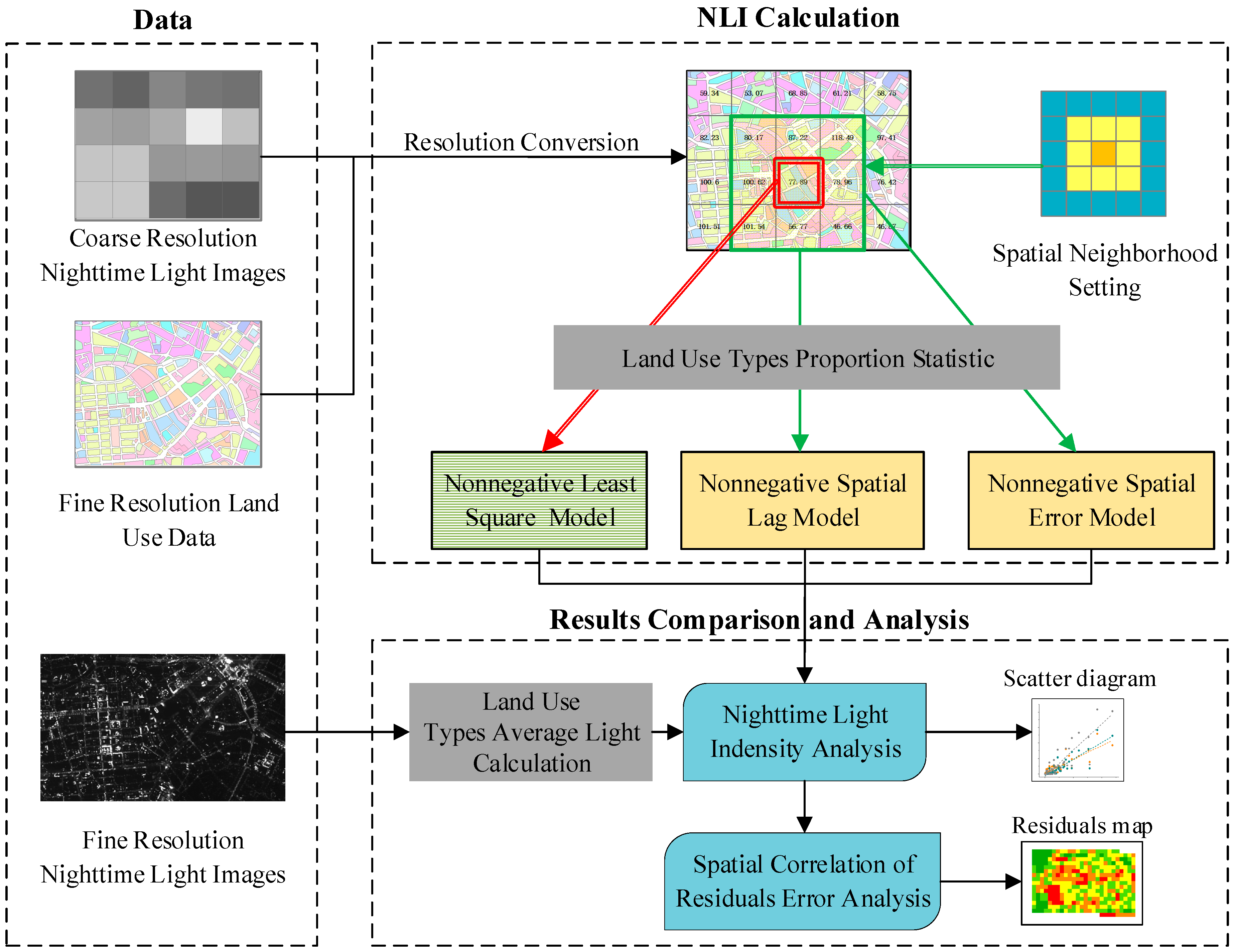
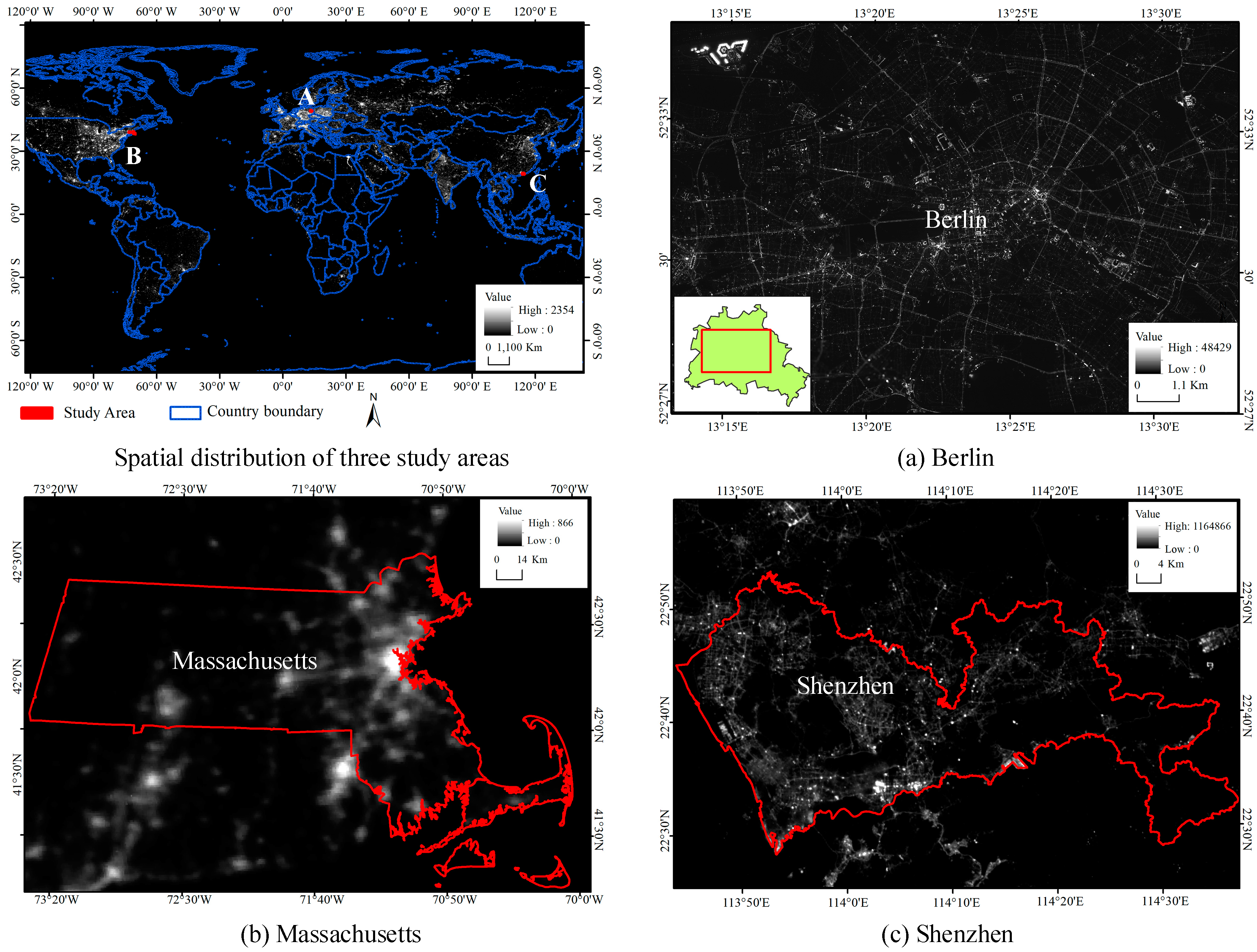
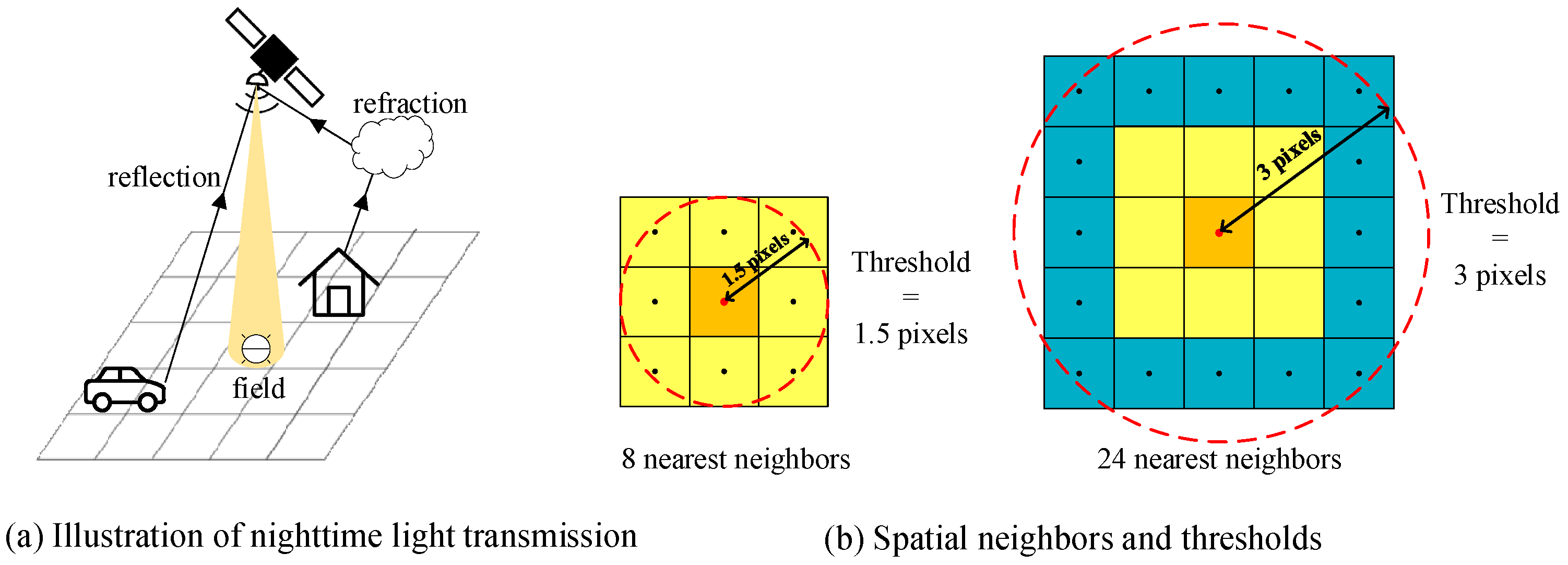
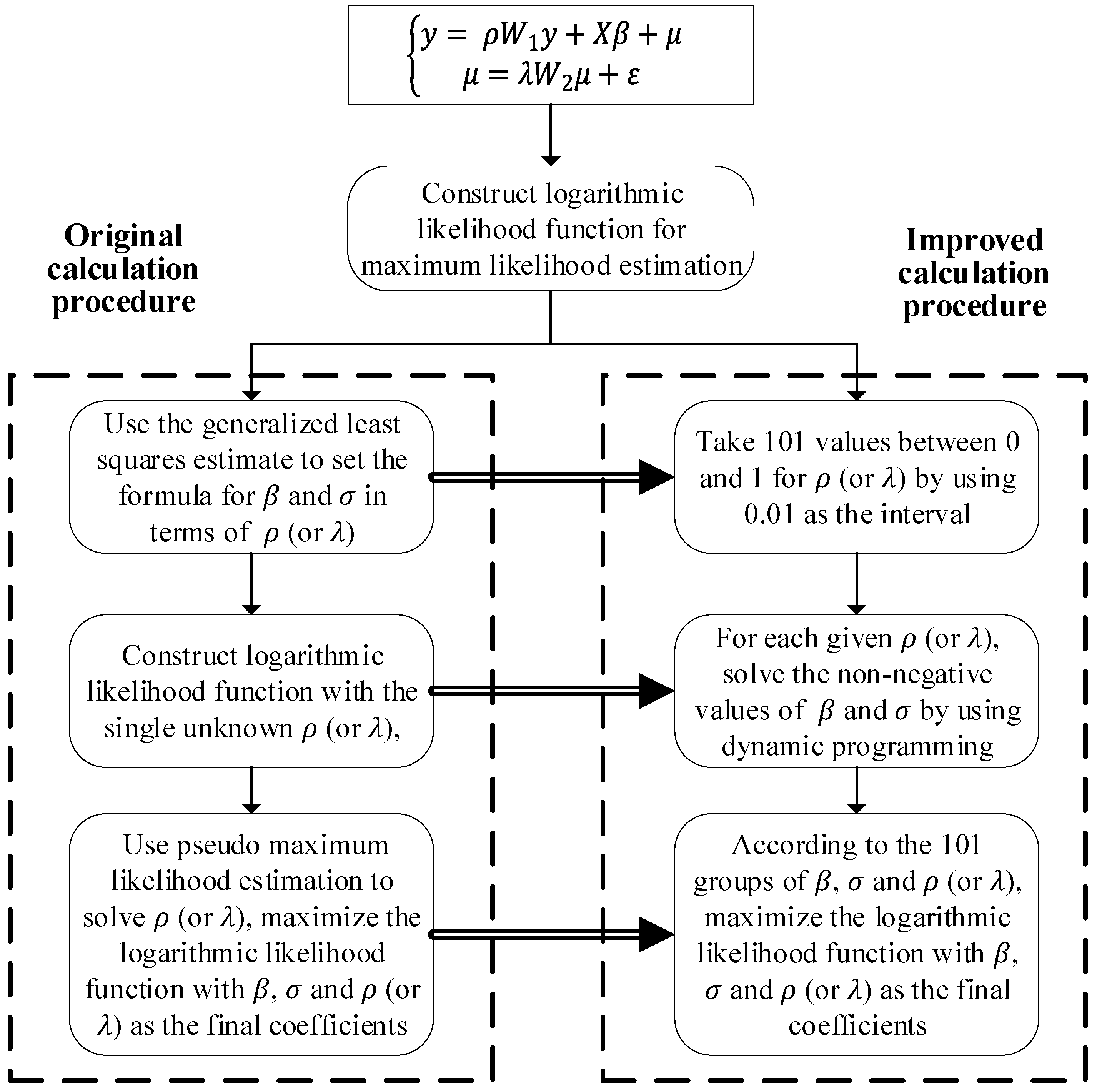
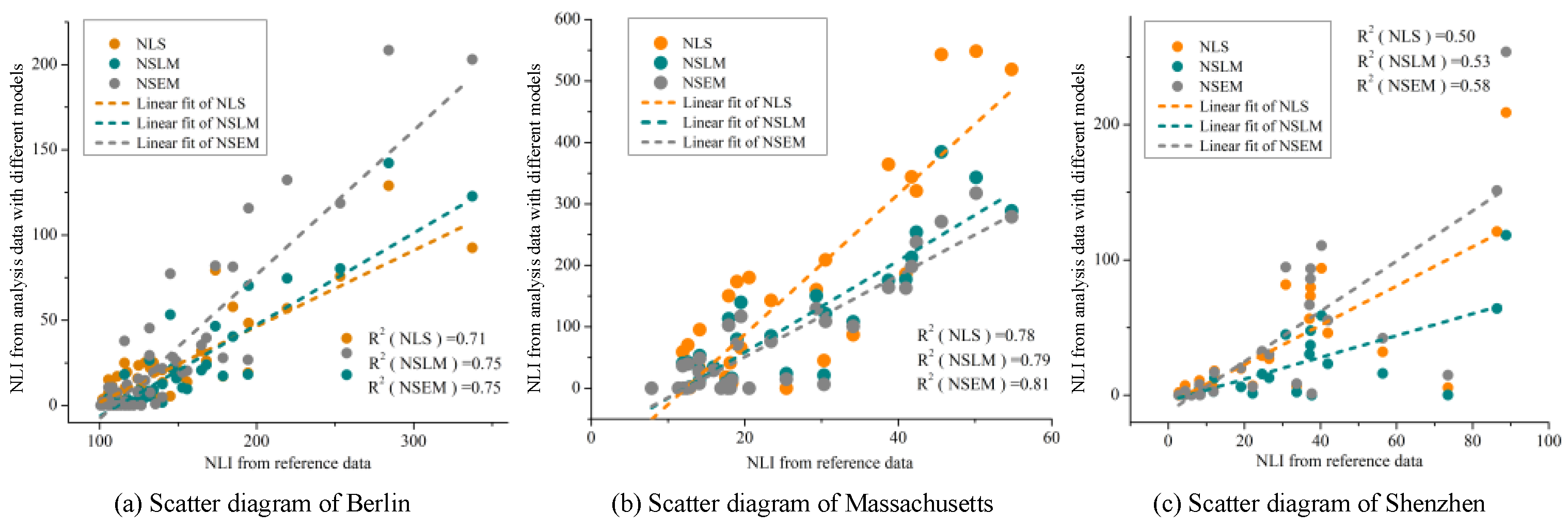
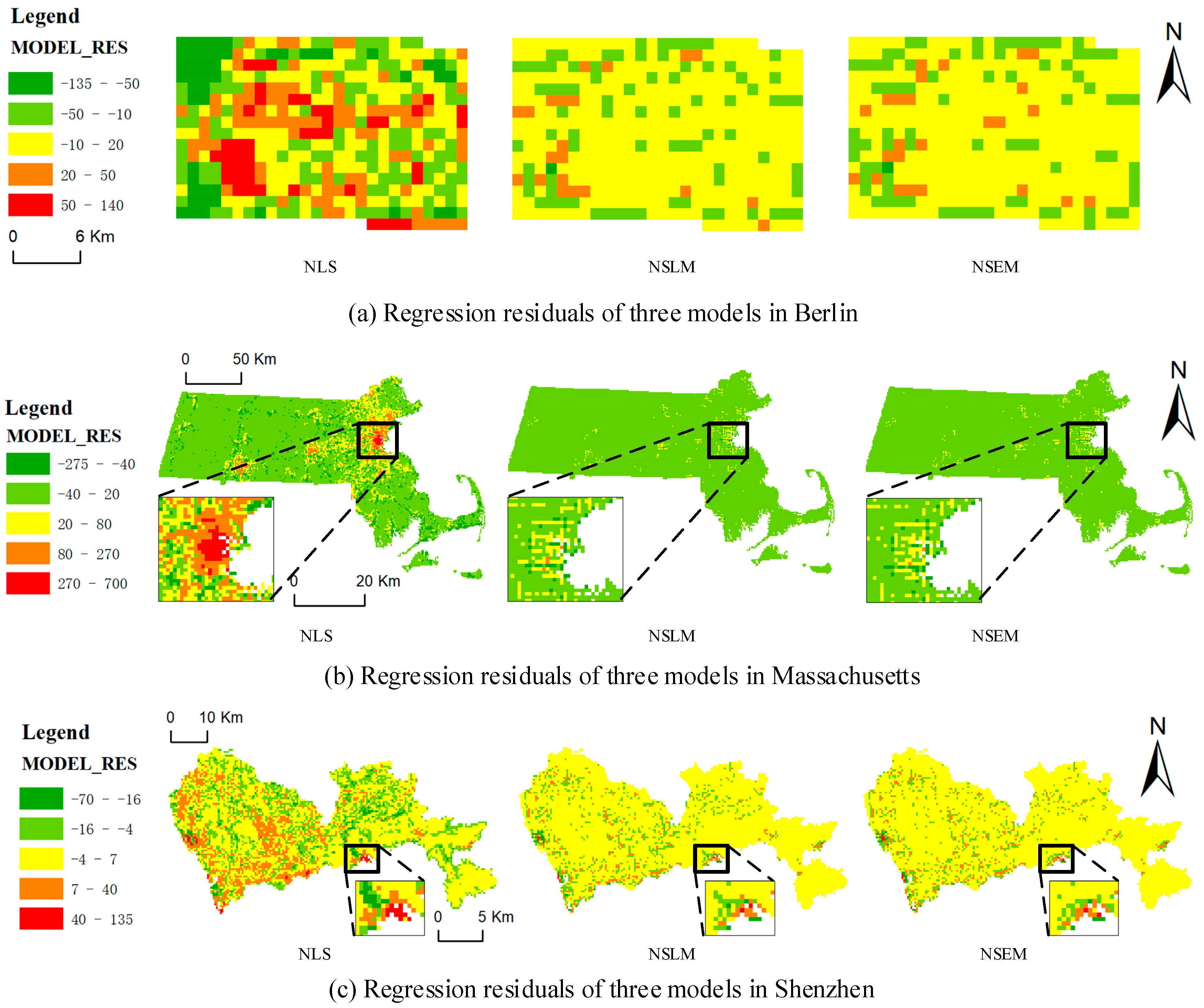

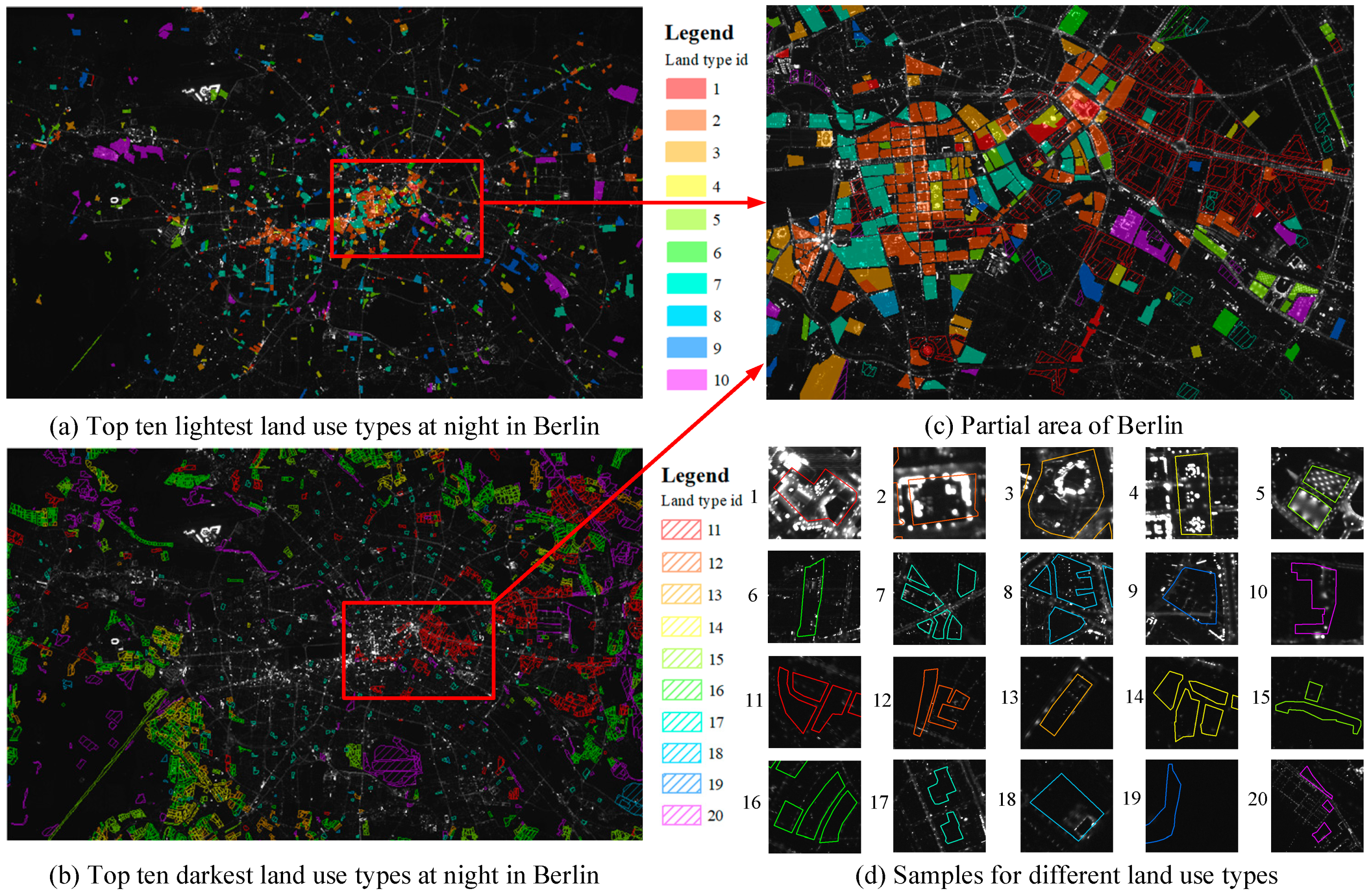

| Data Sources | Berlin | Massachusetts | Shenzhen | ||
|---|---|---|---|---|---|
| Analysis data | Land use Data | Acquisition time | 2010 | 2005 | 2015 |
| Resolution | 5 m | 0.5 m | 1 m | ||
| Number of types | 52 | 33 | 26 | ||
| Coarse resolution nighttime light image | Source | Annual composite product of NPP/VIIRS | DMSP/OLS images | Annual composite product of NPP/VIIRS | |
| Acquisition time | 2012 | 2005 | 2015 | ||
| Resolution | 500 m | 1 km | 500 m | ||
| Reference data | Source | Aerial photography | Photograph from the International Space Station | Product from LuoJia1-01 | |
| Acquisition time | 2011 | 2010 | 2018 | ||
| Resolution | 1 m | 30 m | 170 m | ||
| Study Area | AIC | ||
|---|---|---|---|
| NLS | NSLM | NSEM | |
| Berlin | 5462.47 | 4326.10 | 4358.73 |
| Massachusetts | 269,392.46 | 182,997.35 | 184,658.20 |
| Shenzhen | 62,316.81 | 56,429.73 | 56,482.67 |
| Study Areas | Moran’s I | Residual Accumulation | ||||
|---|---|---|---|---|---|---|
| NLS | NSLM | NSEM | NLS | NSLM | NSEM | |
| Berlin | 0.49 | −0.11 | −0.08 | 13,329.59 | 7887.78 | 8006.55 |
| Massachusetts | 0.64 | 0.23 | 0.15 | 495,257.68 | 246,287.95 | 250,681.10 |
| Shenzhen | 0.5 | 0.16 | 0.12 | 51,733.93 | 30,717.50 | 30,817.50 |
| Study Area | Distance threshold | |||||
|---|---|---|---|---|---|---|
| 0.75 km | 1.5 km | 3 km | ||||
| NSLM | NSEM | NSLM | NSEM | NSLM | NSEM | |
| Berlin | 0.75 | 0.75 | 0.68 | 0.69 | 0.25 | 0.22 |
| Massachusetts | / | 0.79 | 0.81 | 0.63 | 0.56 | |
| Shenzhen | 0.53 | 0.58 | 0.4 | 0.42 | 0.35 | 0.31 |
| Land Use Type | Shenzhen | Shanghai | Wuhan | Taiyuan | Harbin |
|---|---|---|---|---|---|
| Cropland | 20.08 | 8.40 | 2.60 | 2.07 | 0.17 |
| Forest | 8.05 | 6.53 | 1.18 | 0.17 | 0.07 |
| Grass | 19.96 | 11.05 | 8.14 | 0.79 | 0.51 |
| Shrub | 9.95 | 10.79 | 0.86 | 0.14 | 0.06 |
| Wetland | 28.75 | 8.60 | 3.57 | 2.20 | 0.08 |
| Water | 17.41 | 2.99 | 2.78 | 4.85 | 0.56 |
| Impervious surface | 31.34 | 29.16 | 24.16 | 21.43 | 9.37 |
| Bare land | 41.45 | 16.55 | 20.63 | 5.67 | 1.83 |
| City | Shenzhen | Shanghai | Wuhan | Taiyuan |
|---|---|---|---|---|
| Area (Square Kilometer) | 1997 | 6341 | 8596 | 1500 |
| Investment Completed in Current Year (100 million Yuan) | 3298.31 | 2880.45 | 7680.89 | 2025.60 |
| Cost of New Construction (100 million Yuan) | 2521.82 | 1837.92 | 3306.86 | 1016.50 |
| Proposition of New Construction in all investment | 76% | 64% | 43% | 50% |
© 2020 by the authors. Licensee MDPI, Basel, Switzerland. This article is an open access article distributed under the terms and conditions of the Creative Commons Attribution (CC BY) license (http://creativecommons.org/licenses/by/4.0/).
Share and Cite
Zheng, H.; Gui, Z.; Wu, H.; Song, A. Developing Non-Negative Spatial Autoregressive Models for Better Exploring Relation Between Nighttime Light Images and Land Use Types. Remote Sens. 2020, 12, 798. https://doi.org/10.3390/rs12050798
Zheng H, Gui Z, Wu H, Song A. Developing Non-Negative Spatial Autoregressive Models for Better Exploring Relation Between Nighttime Light Images and Land Use Types. Remote Sensing. 2020; 12(5):798. https://doi.org/10.3390/rs12050798
Chicago/Turabian StyleZheng, Honghan, Zhipeng Gui, Huayi Wu, and Aihong Song. 2020. "Developing Non-Negative Spatial Autoregressive Models for Better Exploring Relation Between Nighttime Light Images and Land Use Types" Remote Sensing 12, no. 5: 798. https://doi.org/10.3390/rs12050798
APA StyleZheng, H., Gui, Z., Wu, H., & Song, A. (2020). Developing Non-Negative Spatial Autoregressive Models for Better Exploring Relation Between Nighttime Light Images and Land Use Types. Remote Sensing, 12(5), 798. https://doi.org/10.3390/rs12050798






